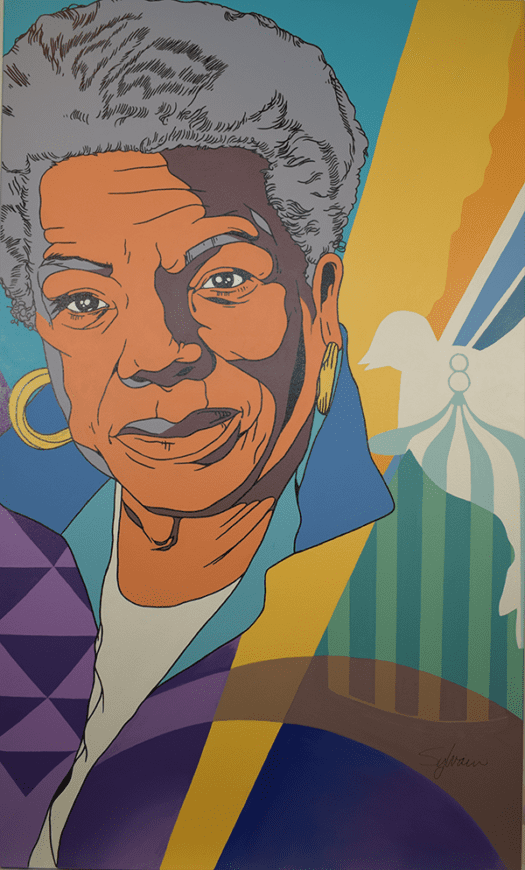Dark Testament – Portraits
… …
Learn more about 16 influential Black writers whose work covers more than 100 years of American history through original works of art created specifically for Dark Testament by contemporary Black artists Bernard Williams, Damon Reed, Dorian Sylvain, and Dorothy Irene Burge.
… Likewise, when Emily Dickinson states, “I am Nobody? Who are you?,” it is newcomers she is addressing, too. And when in “Song of Myself” Walt Whitman says, “I’m very large, I contain multitudes,” he is talking of the rest of us, those here today, yesterday, and tomorrow. Immigrants not only hear these clarions; immigrants are the clarion. We connect America with every single crevice of the world. The world’s heart palpitates in us. Engli…
… “My family first fled France and migrated to Ireland due to religious persecution. They then later fled Ireland and came to America in 1858 because of religious persecution again. Our family’s history here has always been to live a liberated life w/ our family free of judgement.” …
Frederick Douglass (1818-1895) was a formerly enslaved person who became a well-known public speaker and author. He used his words to transform a world that often refused to recognize his humanity. Eventually, he found his home in Washington, DC, where he continued his activism for racial and social justice.
“What, to the American slave, is your Fourth of July? I answer: a day that reveals to him, more than all other days in the year, the gross injustice and cruelty to which he is the constant victim.”
In this speech Douglass charged his white audience to consider what independence meant for enslaved people. His forceful words highlight the hypocrisy of slaveholders celebrating freedom. Douglass closes his speech by reminding his audience that they have the power to bring about change if they are willing to do so.
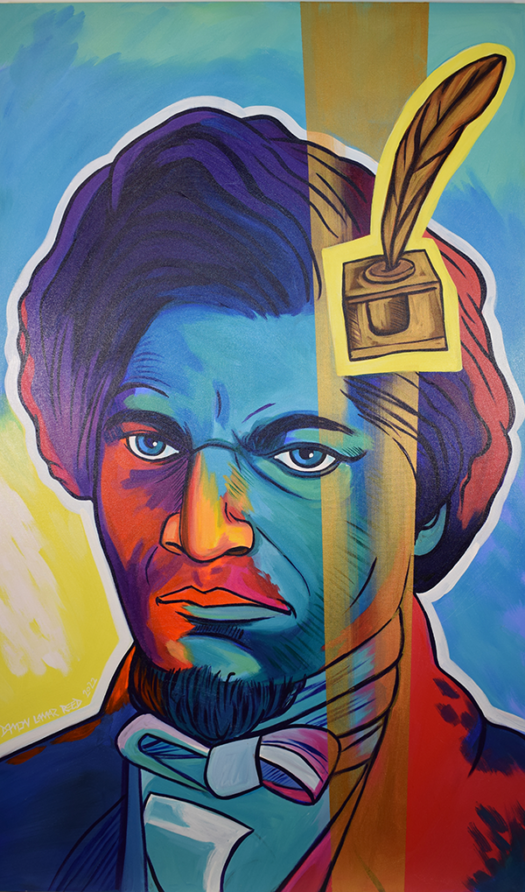
Ida B. Wells (1862-1931) was a journalist whose reporting on lynching is still important today. Her writing condemned anti-Black violence, and she fought for a better future. The Adinkra symbol at the bottom right stands for strength, resourcefulness, and defiance of oppression.
“In lynching, opportunity is not given the Negro to defend himself against the unsupported accusations of white men and women. The word of the accuser is held to be true and the excited bloodthirsty mob demands that the rule of law be reversed…”
Ida B. Wells’ pamphlet documented the rise of white mob violence and the horrors of black lynchings in the southern United States. She found that more than 10,000 Black people had been murdered by lynching, and began a campaign of education to end the carnage.
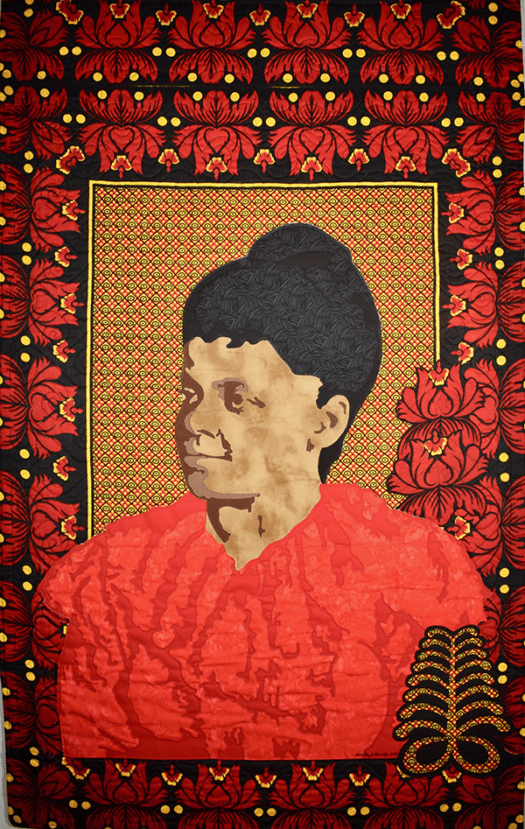
Paul Laurence Dunbar’s (1872-1906) thoughtful gaze would have been well-known to those around him. He became known for writing in the Black dialect of his time. The oak leaves represent his first book of poetry, Oak and Ivy, which contained many poems that discussed racial prejudice.
In high school, Dunbar was already showing promise as a published poet in the Dayton Herald, and an editor for the Dayton Tattler. The Tattler was a short-lived Black paper in Ohio published by Dunbar’s classmate Orville Wright (later known as the co-inventor of the airplane). His poetry only represents a small part of his many novels, short stories, essays, and poems. He was quite prolific for years despite becoming ill, and started to gain wider recognition outside of Ohio, particularly after going on several “reading tours.” He died when he was only 33, leaving behind a literary legacy as one of the foremost Black poets of his day.
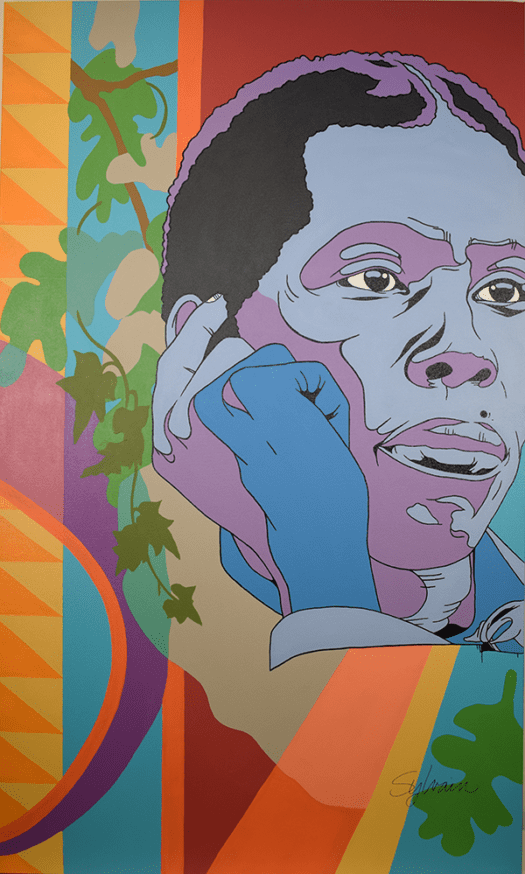

Dorothy Burge is a fabric and multimedia artist and community activist who is inspired by history and current issues of social justice. She is a self-taught quilter who began creating fiber art in the 1990s after the birth of her daughter, Maya.
Dorothy is a native and current resident of Chicago, but is descendent from a long line of quilters who hailed from Mississippi. These ancestors created beautiful quilts from recycled clothing. While she showed no interest in this art form as a child, she grew to treasure the quilts that were created by family elders. Her realization that the history and culture of her people were being passed through generations in this art form inspired her to use this medium as a tool to teach history, raise cultural awareness, and inspire action.
Ma Rainey (1886-1939) inspired a generation of Black musicians as the “Songbird of the South.” As one of the earliest blues singers, her music was full of life and soul. Sadly, the importance of her contributions has often been downplayed by historians, and much of her music lost over the years.
Born Gertrude Pridgett, Rainey began her stage career by performing in her parents’ minstrel show. She acquired the nickname “Ma Rainey” through her marriage to William “Pa” Rainey in 1904. Together, the duo toured the South as the “Assassinators of the Blues.” Already a beloved figure in the Southern theater circuit, Ma Rainey became wildly popular during the Blues craze of the 1920s with hits such as “Moonshine Blues” and “Ma Rainey’s Black Bottom.” She established herself in the music industry as a prolific songwriter and a shrewd businesswoman, recording nearly a hundred records between 1923-1928. Ma Rainey’s legacy went on to inspire Langston Hughes, Sterling Brown, and Alice Walker.
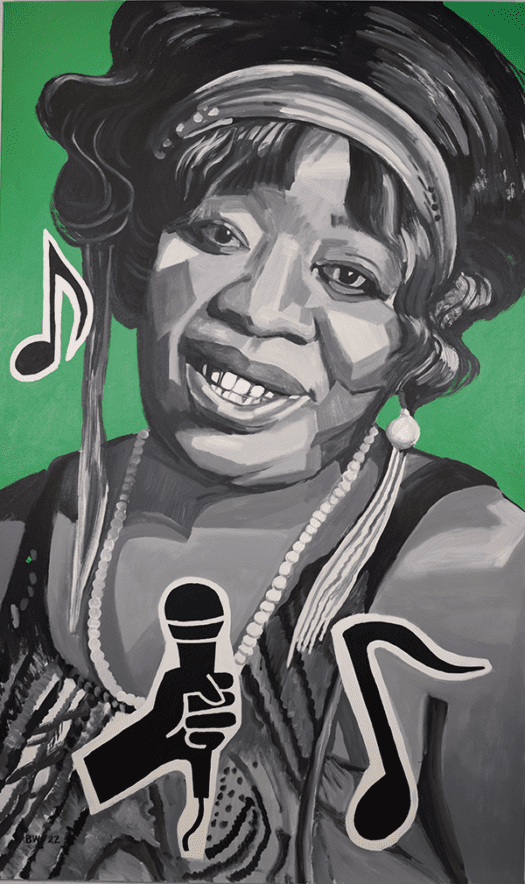
Frances Ellen Watkins Harper (1825-1911) was a lifelong advocate for abolition and civil rights for Black people and women. She paved the way for women through her writing, speaking, poetry, and activism. In 1859, Harper became the first known African American woman to publish a short story.
Orphaned at age three, Frances Ellen Watkins Harper learned about abolition and advocacy from her aunt and uncle in Maryland. As an adult, she traveled to work as a schoolteacher, but was barred from returning to Maryland when the state passed a bill that prohibited free African Americans entry. Unable to return home, Harper turned her attention to the antislavery movement. Today, Harper is celebrated as a leading antislavery suffragette.
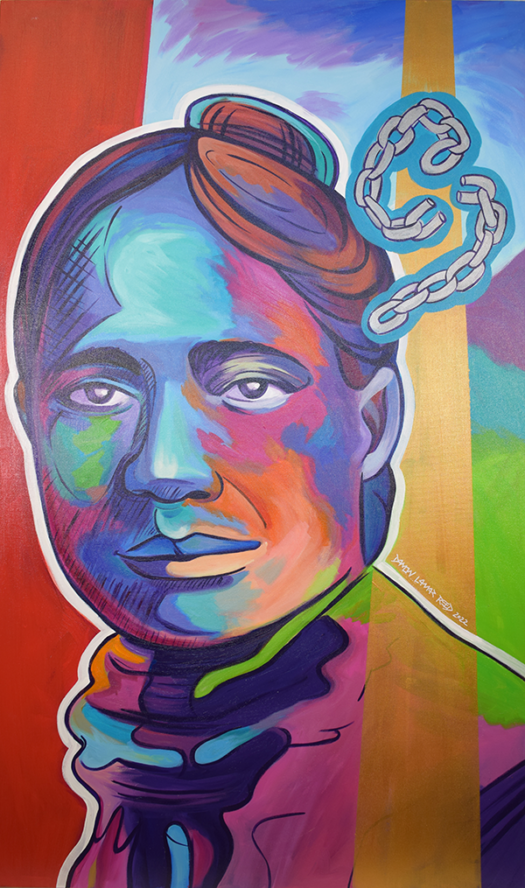
With a white mother and half-sister, Nella Larsen (1891-1964) never felt like she fit in. Her skin was too dark for the immigrant community her mother came from, and too light for the Black community. The hourglass here represents her internal conflict.
Nella Larsen was a brilliant writer who was lost to obscurity for many years after her death. She published 2 novels, Quicksand and Passing, as well as several short stories. In 1930, she was the first Black woman to be awarded a Guggenheim fellowship, but she never published again. Her novels and stories encapsulated her experience as a biracial woman. In addition to her literary career and a brief stint as a librarian, Larsen worked as a nurse for more than 20 years. Today, her work is celebrated and studied in universities across the country.
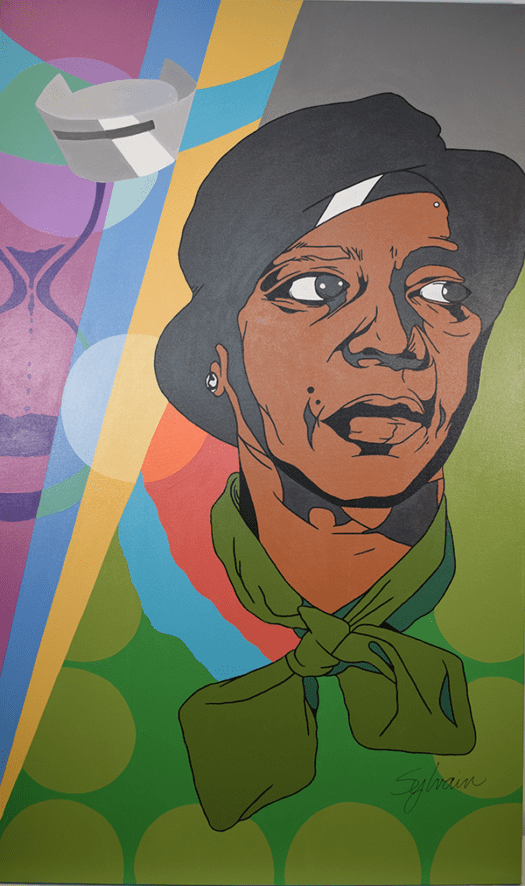
Born in Phoenix, Arizona, Damon Lamar Reed moved to Chicago in 1996 to attend The School of the Art Institute. After receiving his B.F.A. in 1999, he became a full-time freelance artist making a career out of mural painting, illustration, graphic design, fine art, and teaching. Many of his murals and bricolages can be seen around the Midwest. Damon’s work with various organizations has allowed him to work with young aspiring artists, as well as to perfect his own creative designs. Reed has also built his portfolio to combine music with his visual arts skills.
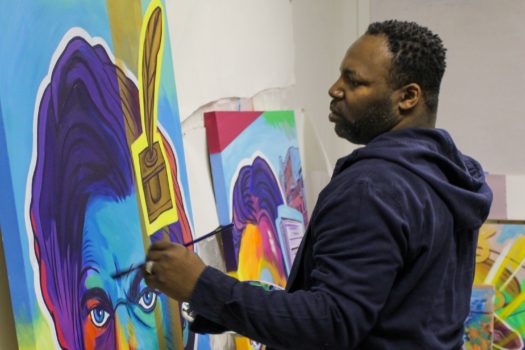
Langston Hughes (1902-1967) used poetry to address racial justice. He was inspired by many things, particularly blues and jazz music. His writing helped shape the Harlem Renaissance.
In a deep song voice with a melancholy tone
I heard that Negro sing, that old piano moan—
‘Ain’t got nobody in all this world,
Ain’t got nobody but ma self.
I’s gwine to quit ma frownin’
And put ma troubles on the shelf.’
Langston Hughes’ famous poem, “The Weary Blues,” is both a celebration of Black culture and a lament for the hardship faced by Black people. He directly references Harlem in several instances, showing the neighborhood’s importance. Hughes used his narrative voice and the musician’s lyrics to convey a community overwhelmed with problems, but determined to move forward.
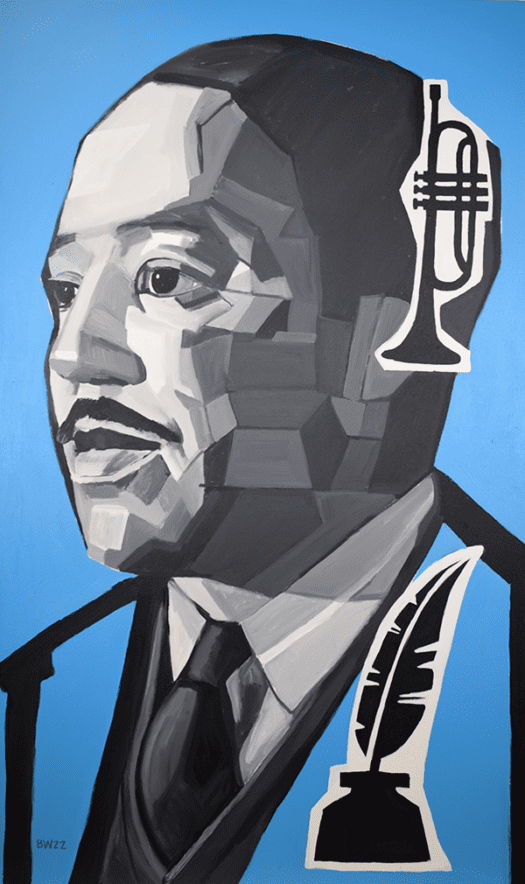
W.E.B. Du Bois (1868-1963) made the case for African Americans to receive full civil rights. Yet, he always felt out of place in the world. When he was in his 90’s, he moved to Accra, Ghana, a country where he felt at home and whose flag is shown here. He became a Ghanaian citizen two years before his death.
“One ever feels his two-ness, – an American, a Negro; two souls, two thoughts, two unreconciled strivings; two warring ideals in one dark body, whose dogged strength alone keeps it from being torn asunder”
Du Bois wrote The Souls of Black Folk to give voice to the complex experiences of Black Americans. Many were torn between belonging to the Black community and being rejected as Americans by whites. This book was written with a white reader in mind, and spells out the fundamental separation that Du Bois felt.

Richard Wright (1908-1960) criticized the whitewashed myth of the American Dream. His protest novel Native Son and his autobiography Black Boy received critical acclaim and showed the challenges poor Black people faced. The Adinkra symbol near Wright’s papers literally means “bite not one another,” which suggests his connection to the Black solidarity movement.
Richard Wright was the grandchild of former enslaved people, and was well acquainted with poverty. He moved from relative to relative as a child and as an adult moved from one unskilled job to another until he ended up in Chicago. In 1937, he went to New York where he became the editor of the communist paper Daily Worker. He moved to Paris permanently after World War II.
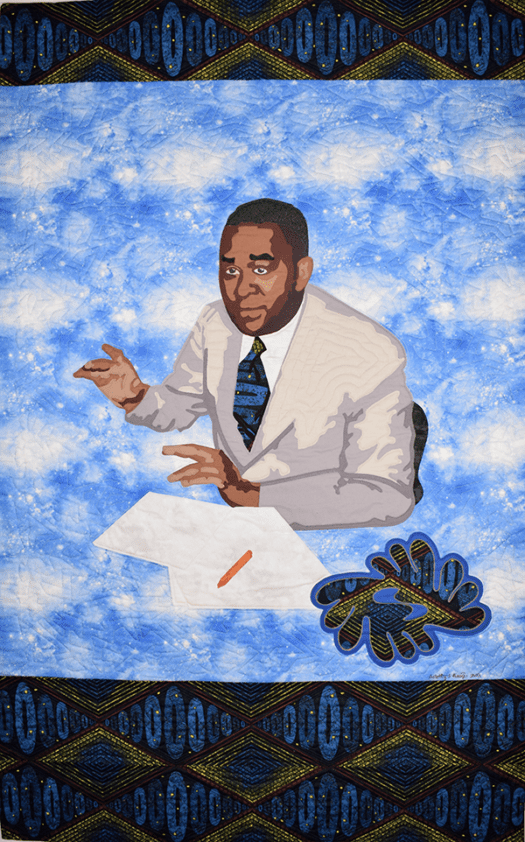

Dorian Sylvain is a painter whose color and texture explore ornamentation, pattern, and design as identifiers of cultural and historical foundations. She is a studio painter and muralist, as well as an art educator, curator, and community planner. Much of her public work addresses issues of beautification inspired by color palettes and patterns found throughout the African diaspora, particularly architecture. Core to her practice is collaborating with children and communities to elevate neighborhood aesthetics and foster shared understanding.
Pauli Murray (1910-1985) was a poet, activist, lawyer, and priest who fought for justice and equality. Murray was the first African American woman ordained as an Episcopal priest. The cross in the background emphasizes her strong commitment to religion, while the bus in the foreground represents her involvement in the Civil Rights Movement.
This is our portion, this is our testament,
This is America, dual-brained creature,
One hand thrusting us out to the stars,
One hand shoving us down in the gutter.
The poem “Dark Testament” inspired the name of this exhibit because it exemplifies the complexity of Black life in America. Murray faced violence, struggled with belonging, fought tirelessly for justice, and preached about joy. Their epic poem captures that experience beautifully.
Visit the online exhibit Pauli Murray: Survival With Dignity
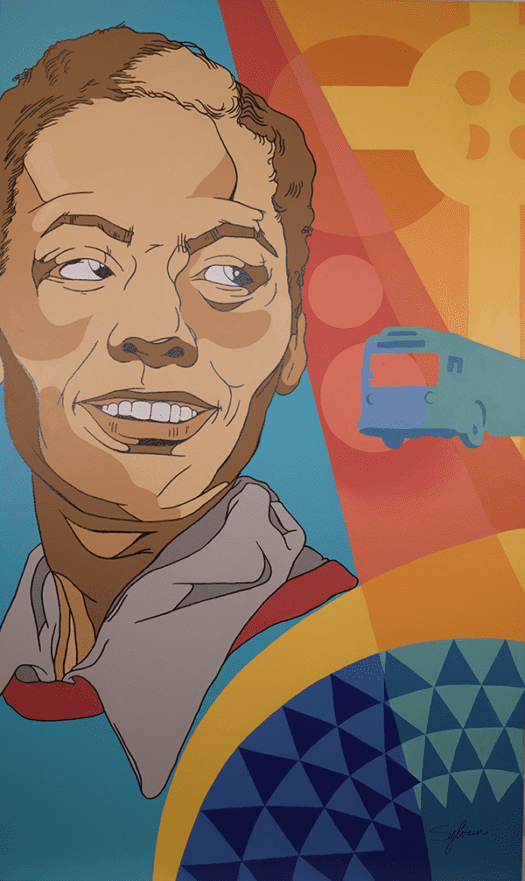
Zora Neale Hurston (1891-1960) studied anthropology in college. Her education and interest in the lives of African Americans laid the foundation for her to write about the depth and breadth of Black experiences. The Adinkra symbol on her dress represents the supremacy of God over all beings. This symbol was chosen in reference to Hurston’s novel Their Eyes Were Watching God.
Sometimes God gits familiar wid us womenfolks too and talks His inside business. He told me how surprised He was ’bout y’all turning out so smart after Him makin’ yuh different; and how surprised y’all is goin’ tuh be if you ever find out you don’t know half as much ’bout us as you think you do.
Zora Neale Hurston wrote this novel, in part, to highlight limitations women face. She examined the intersection of gender, race, and class within Black communities through a series of relationships in the book. Some critics thought that Hurston was promoting stereotypes, which caused a rift with some of her fellow writers.
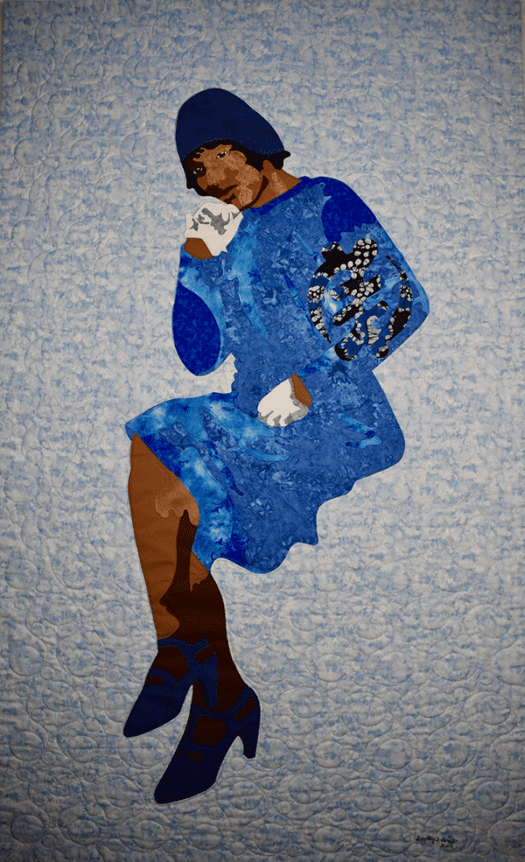
Ethel Payne (1911-1991) was a fearless reporter who would not back down from contentious social issues. She became known as the “First Lady of the Black Press” due to her commitment to justice and journalistic excellence.
Payne began writing about the Korean War in her journal around 1950, and was hired by the Chicago Defender after a reporter saw her journals. Using simple and straightforward language, Payne reported on topics ignored by the white press. These issues included the poor treatment of African American troops, General MacArthur’s refusal to desegregate the American military, the abandoned babies of Black soldiers and Japanese mothers, and the Black adoption crisis. In 1970, Payne was hired by CBS, becoming the first African American woman to be a TV and radio anchor for a national news network. Though her legacy as a journalist has been overlooked up until recently, her writing is coming back into the light.

Bernard Williams’ studio practice embraces a range of formats for the expression of his interests and concerns. He has created projects which investigate the complexities of American history and culture through painting, sculpture, and installation. Within these broad arenas, the work seeks a kind of open-ended dialogue, addressing identity, flattening hierarchies, and questioning who we are collectively. Risk, adventure, conquest, personal status, privilege, and mechanical development are some of the thematic concepts which are pushed into form.
His works attempt to address our connections and disconnections within a turbulent human history. Not all the signs and images used are clearly identifiable or penetrable.
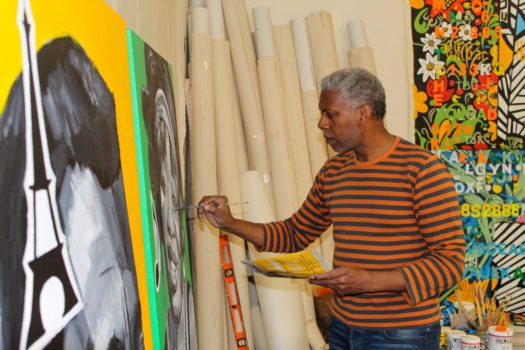
James Baldwin (1924-1987) was a powerful writer and speaker whose words both captured and influenced the long Civil Rights Movement. After moving to France to finish his novels, he found a sense of belonging there that he didn’t feel in Harlem, New York.
Baldwin left for Paris in 1948, beginning a life as a self-styled “transatlantic commuter” who split his time between France and the United States. He launched his literary career with 1953’s semi-autobiographical book Go Tell It on the Mountain. Baldwin’s passionate discussion of race, gender, sexuality, and class in works such as Giovanni’s Room (1956), Nobody Knows My Name (1961), and The Fire Next Time (1963) were instrumental in shaping the Civil Rights movement. Baldwin made it his mission to “bear witness to the truth.”
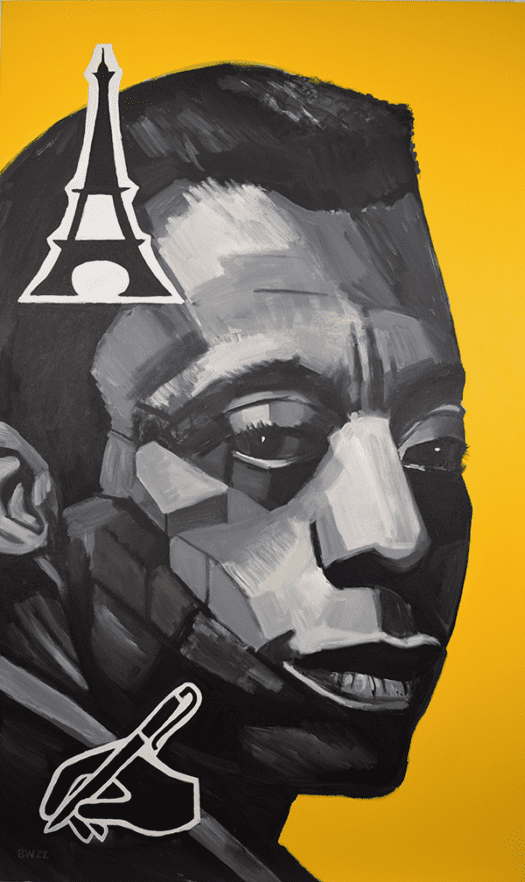
Ralph Ellison (1914-1994) wove together elements of Black culture – music, novels, folklore, philosophy, and history – into his famous novel Invisible Man. He showed the pain of trying to belong in a place that doesn’t see people for anything more than their skin color. The Adinkra symbol near his leg represents toughness in spite of opposition.
I’m an invisible man and it placed me in a hole—or showed me the hole I was in, if you will—and I reluctantly accepted the fact. What else could I have done?
Invisible Man is considered by many to be a masterpiece of American literature. When it was published, it was met with praise, but also criticism from some of Ellison’s fellow writers. For today’s readers, the novel defines the time in which it was written. Many of its themes continue to speak to the present moment.
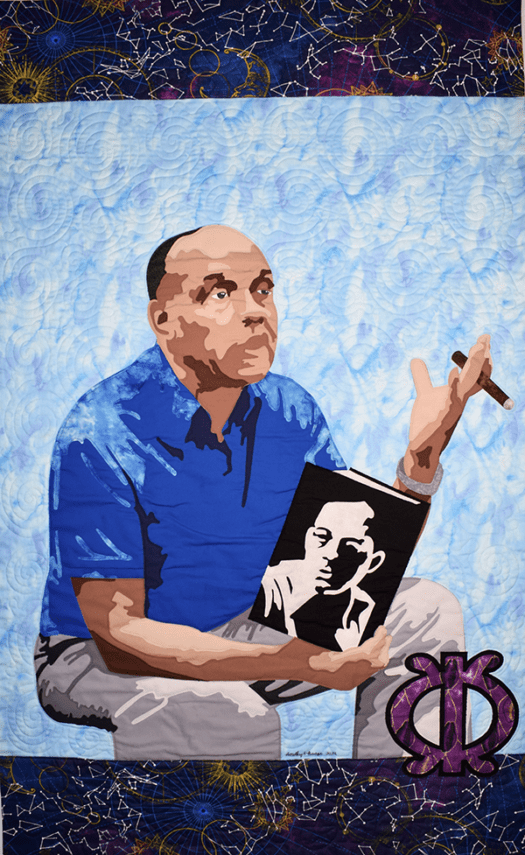
Malcolm X (1925-1965) redefined the Civil Rights Movement as a fight for human rights. He was a member of the Nation of Islam, a black nationalist religious group symbolized by the crescent and star. Malcolm X believed that peaceful protests would not stop acts of violence against people struggling for their rights. He urged his audience to secure their equality by “any means necessary.”
Malcolm X was born Malcolm Little in Nebraska. As a child, he lived in foster care for several years before moving in with his older half-sister. As a teenager, he committed several petty crimes and ended up in prison. There, he converted to the Nation of Islam, a combination of the teachings of Islam and Black nationalism. He rose through the ranks quickly and became second in command to Elijah Muhammed. Between 1955 and 1965, Malcolm came to represent the anger and frustration felt during the Civil Rights Movement. He also was one of the first to use the terms Black or Afro-American instead of Negro or colored. In 1964, he left the Nation of Islam and converted to Sunni Islam. This caused a rift with the Nation, leading to his assassination by Nation member Talmadge Hayer.

Maya Angelou (1928-2014) was a respected spokesperson for Black people and women. Her slight smile and kind eyes convey the joy and beauty she brought to her writing. While her works touch on many difficult themes, the hope she embraced is symbolized by the flying bird.
Angelou is best known for her series of seven autobiographies, which cover her childhood and early adult experiences. Before becoming a writer, Angelou worked many odd jobs, including as a fry cook, sex worker, nightclub performer, actress, and foreign correspondent. I Know Why the Caged Bird Sings, which tells some of those stories, brought her international recognition. Following its publication, she became a well-known spokesperson for Black people and women, and is widely seen as a defender of Black culture. Angelou was active in the Civil Rights Movement and worked actively with both Martin Luther King, Jr. and Malcolm X. Today, her works are widely used in schools and universities worldwide, although attempts have been made to ban her books from some US libraries.
